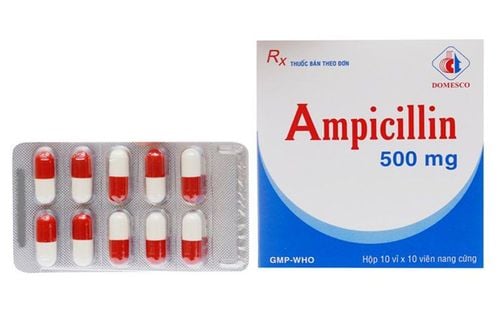Ciprinol is a drug used to treat conditions such as prostatitis, osteomyelitis, severe bacterial enteritis, sepsis, and other severe infections where conventional antibiotics are ineffective. To ensure effective use, patients should follow doctor's instructions and refer to the information regarding Ciprinol's uses.
1. What are the uses of Ciprinol?
1.1. What is Ciprinol?
Ciprinol 200mg is used to treat conditions such as prostatitis, osteomyelitis, severe bacterial enteritis, sepsis, and infections in other organs or parts of the body.
Ciprinol 200mg contains the active ingredient Ciprofloxacin at a concentration of 200mg/100ml. It is formulated as an intravenous solution packaged in 100ml bottles.
1.2. What is the effect of Ciprinol?
Ciprinol contains Ciprofloxacin, an active ingredient in the Quinolone group. This is a broad-spectrum antibiotic with high bactericidal effects, quickly reducing bacterial reproduction. It is also effective against conventional antibiotic-resistant bacteria such as penicillin, cephalosporins, and tetracyclines. Moreover, Ciprofloxacin can be used synergistically with other medicines in treatment.
Indications for use:
- Pneumonia, bronchitis, pleuritis, lung abscess, bronchiectasis with superinfection, and acute exacerbation of chronic bronchitis.
- Acute and chronic glomerulonephritis, prostatitis, cystitis.
- Otitis media or sinusitis.
- Gonococcal infections.
- Skin and soft tissue infections.
- Infectious diarrhea, peritonitis, cholangitis, pelvic inflammatory disease, and osteoarthritis infections.
- Sepsis.
Contraindications:
- People allergic to Quinolone antibiotics. Children are much less likely to receive Cipronol due to risk of severe adverse effects
- Individuals hypersensitive to any components or excipients of the drug.
- Other cases as specified in Ciprinol's usage instructions or the doctor's prescription.
2. How to use Ciprinol
2.1. How to administer Ciprinol
Ciprinol is available as an injectable solution and is administered intravenously. Intravenous infusion should be slow (over 60 minutes) and performed by medical professionals.
2.2. Dosage of Ciprinol
For adults:
- For urinary tract infections: 100mg per dose, twice a day.
- For lower respiratory tract infections: 200mg per dose, twice a day.
- For other infections: 200mg per dose, twice a day.
- For gonorrhea: 150mg per dose, once daily.
For children:
Children and adolescents: Intravenous infusion of 5–10 mg per kg per day, over 30–60 minutes.
Managing missed doses:
If a dose is missed during the treatment process, take it as soon as you remember (Usually, the medication can be taken 1 to 2 hours before or after the time prescribed by the doctor). If it is close to the next dose, skip the missed dose and continue with the regular schedule. Do not double the dose to make up for the missed one.
Overdose management:
In emergencies or if an overdose occurs with dangerous symptoms, immediately call Emergency Center 115 or go to the nearest medical facility. Relatives should provide doctors with the list of drugs or prescriptions being used for timely diagnosis.
3. Precautions when using Ciprinol
Dosage should be reduced in patients with impaired kidney or liver function. For those with renal dysfunction, with low dose using, adjustments are not necessary. In contrast, high doses intake should be adjusted pivot on creatinine clearance or serum creatinine levels.
Use caution in patients with central nervous system disorders such as cerebral arteriosclerosis or epilepsy.
During pregnancy:
Patients should carefully consider and consult a doctor or pharmacist before using Ciprinol, as drugs, even after testing, may pose risks.
During breastfeeding:
Breastfeeding mothers should carefully weigh the benefits and risks for both mother and baby. Do not use Ciprinol without thoroughly reading the instructions and consulting a doctor to protect both mother and child.
4. Side effects of Ciprinol
- Less common side effects: Gastrointestinal disorders such as heartburn, nausea, abdominal pain, loss of appetite, diarrhea, bloating, headache, dizziness, elevated creatinine levels, and increased liver enzymes.
- Rare side effects: Shock, photosensitivity, edema, rash, acute renal failure, stomatitis, jaundice, hematologic changes, pseudomembranous colitis, joint pain, and muscle pain.
- Patients experiencing unusual symptoms during Ciprinol use should inform their doctor immediately.
5. Ciprinol drug interactions
Ciprinol interactions with other drugs can be complex due to multiple active ingredients and excipients. Research or recommendations typically highlight common interactions. Therefore, patients should not independently apply information about Ciprinol 200mg interactions without being researchers, doctors, or medical professionals.
- Do not use Ciprofloxacin concurrently with Tizanidine.
- Ciprofloxacin interacts with theophylline, NSAIDs, antacids, sucralfate, metal ions, and cyclosporine.
- Inform the doctor about all medications being taken to avoid adverse effects.
Consider potential interactions with alcohol, tobacco, and fermented beverages, which may alter the drug's effects.
6. How to store Ciprinol
Store Ciprinol in a dry, cool place at temperatures not exceeding 30°C, in its original packaging, and away from light.
The shelf life of Ciprinol is 36 months from the production date.
Keep out of reach of children and pets.
Carefully follow the storage instructions on Ciprinol’s packaging and leaflet of Ciprinol 200mg/100ml. Check the expiration date before use. Dispose of unused Ciprinol as directed by the manufacturer or a healthcare provider.
For further questions, patients should contact their prescribing doctor for in-depth consultation.
To arrange an appointment, please call HOTLINE or make your reservation directly HERE. You may also download the MyVinmec app to schedule appointments faster and manage your reservations more conveniently.













